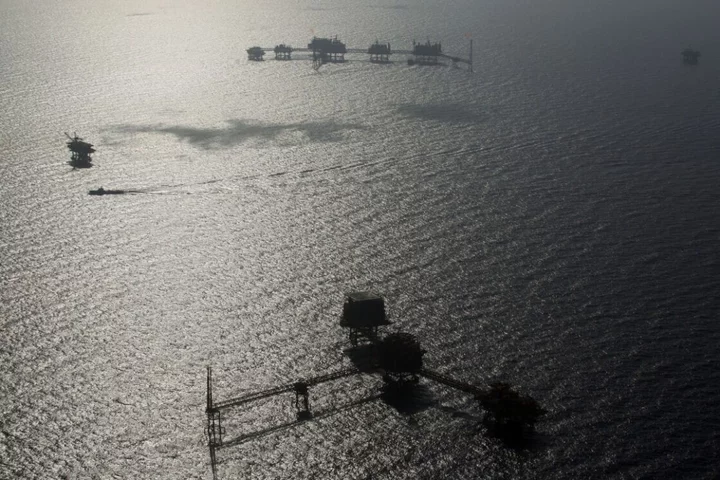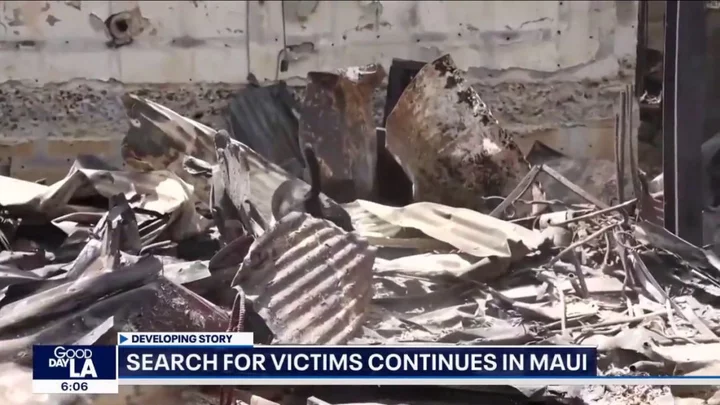COP28 Daily Reports: Sign up for the Green Daily newsletter for comprehensive coverage of the climate summit right in your inbox.
The blotches on grainy satellite images might not mean much to the average person, but to the Spanish scientists experimenting with new ways to track greenhouse gas emissions, they were a staggering discovery.
The snapshots and other data suggested that over 17 days in December 2021, an oil platform operated by Petroleos Mexicanos, the state-owned energy giant known as Pemex, spewed tons of planet-warming methane into the atmosphere. The researchers posited that they were likely caused by two malfunctioning flares and estimated that the amount released was equivalent to about 3% of the annual emissions from Mexico’s entire oil and gas sector.
The scientists documented their findings in a paper published in June last year. That September, one of them, a PhD student in her 20s, said they’d detected another leak from the same platform. That’s when Pemex launched a high-profile campaign attacking the academics and their work. Chief Executive Officer Octavio Romero posted a video on social media of him circling the rig in a helicopter. The information “is totally false” and the study was “irresponsible,” he said, pointing at the flares burning away.
The attempt by an oil corporation to disprove research regarding its pollution is a troubling echo of the industry’s decades-long pushback against scientific research connecting fossil fuels and global warming. While most of these companies backed down from that stance years ago, a nascent movement questioning the ability of satellites to track methane is now casting doubt on a technology that’s increasingly accepted by companies, investors and US and European regulators.
“These are very, very politically powerful corporations protecting their bottom line, and so they attack the science because they don't like its implications," said Naomi Oreskes, a professor at Harvard University and co-author of Merchants of Doubt, which chronicles how companies undermined academic research showing the harmful effects of their products. “They're trying to keep fossil fuels alive and they're trying to downplay the evidence of the very severe harm.’’
Pemex isn’t the only major emitter challenging peer-reviewed studies and widely accepted science that suggest the fossil fuel industry has long underestimated its methane problem. Switzerland-based Glencore Plc has questioned the ability of satellites to accurately identify the source of emissions. Kazakh natural gas explorer Buzachi Neft LLP said what many scientists estimate was the largest methane release this year from fossil fuels was mostly water vapor and carbon dioxide. While the companies acknowledge they’ve released some methane and are working to fix and prevent leaks, they also argue the amounts are being severely overestimated.
Denials like these undermine the credibility of what’s set to be one of the most substantive outcomes from this year’s COP28 climate summit in Dubai. Sultan Al Jaber, the United Arab Emirates minister and oil executive who’s running the talks, is pushing oil companies to eliminate methane emissions and flaring by 2030. The initiative aligns with the host nation’s controversial approach to the annual United Nations negotiations: Instead of focusing on quickly moving away from fossil fuels, it’s pushing for measures to reduce emissions from dirty energy.
Read More: What Is COP28 and Why Is It Important?
For Pemex, accepting that it has a methane problem on the scale of what the latest research says would raise serious questions about the company’s future.
Although capturing methane from oil and gas operations over the longer term is often net positive for operators because there is more product to sell, in the short term it can require a reallocation of capital. Fixing leaks of the size estimated by scientists could impact President Andres Manuel Lopez Obrador’s plan to turn around the world’s most indebted oil company and hurt his party’s prospects in next year’s election, said Adrian Duhalt, a research scholar at Columbia University's Center on Global Energy Policy. It could also drive borrowing costs higher.
Pemex’s response to the Spanish scientists’ paper rested on findings compiled by a consultancy authorized by one of its regulators. That study said the researchers had overestimated the amount of methane by 95% and argued that the bulk of the leak was made up of nitrogen and other gases that “don't affect the environment.” A freedom of information request for the study was rejected.
Satellites can detect concentrations of methane from space when sunlight reflects off the Earth. As light passes through a cloud of gas, its intensity weakens at certain wavelengths. That leaves behind a basic fingerprint that scientists can trace. Nitrogen and methane have different signatures and the short wave infrared sensors that the scientists used to detect Pemex’s methane emissions can't see nitrogen.
"There is no way of mistaking one for the other,” the scientists wrote in response to Pemex. “The startling emissions we reported were 100% methane, plain and simple.”
Pemex and its regulator, the Agency for Safety, Energy and Environment, did not respond to questions about how it reached its conclusions about the leak and the impact it could have on the business. The Mexican government did not respond to queries about the political implications of the research.
Pemex has pledged $2 billion to tackle methane emissions and the company is working with the US Environmental Protection Agency on the issue. But AMLO has also continued to prioritize oil production and the country recently abandoned an effort to reduce its flaring, contributing to some of the world's least efficient energy production. Mexico has the fifth-highest methane emissions per unit of oil and gas output among major suppliers, according to a paper published in Nature Communications.
“The environmental benefits of reducing methane emissions and flaring are less valuable, from a political perspective, than shoring up oil production,” Duhalt said.
Not every satellite image is a pristine snapshot that clearly identifies who’s responsible for a methane leak. Many observations are unusable because of cloud cover. And some materials on the Earth’s surface, like soil with high levels of carbonates, can be hard to distinguish from methane. Scientists tend to discount observations if there's too much uncertainty.
Researchers with the SRON Netherlands Institute for Space Research used 32 clear-sky observations to study methane plumes near Glencore’s Hail Creek coal mine in Australia in 2018 and 2019. In a peer-reviewed paper published in 2021, they estimated the mine spewed so much methane a year that it had the equivalent short-term climate impact as the the annual emissions from between 3.2 million and 5 million US cars US cars. The study suggested the mine’s true contribution to global warming is significantly underestimated in official data.
Glencore disputed the study and said last year atmospheric contaminants like dust, water vapor or smoke can impact the accuracy of satellite measurements. It added that the paper shouldn’t be relied on to estimate the company’s emissions and pointed to a 2021 government report that said it was “premature” to use satellite data that way. The company said it “continues to note questions raised” about the method.
The Australian government said its methane emissions measurement and reporting is consistent with the Paris Agreement’s rules. The climate change and energy department is exploring the use of “satellite-based instruments and other technologies” to improve greenhouse gas estimates at facilities and on a national level.
Those who challenge methane estimates using satellite images should commission independent, third-party scientists to take on-the-ground measurements and make the results public, said Peter Rayner, an atmospheric sciences professor at the University of Melbourne. “Not believing the study is fine,” said Rayner, who wasn’t involved in the SRON report. “Not being prepared to find out the answer is unacceptable.”
As technology advances and awareness of the dangers of methane grows, many energy producers are embracing new technologies such as satellites and aircraft armed with spectrometers to clean up their operations.
GHGSat Inc., a private satellite company that helps companies search for methane emissions, has worked with oil and gas giants including Shell Plc and TotalEnergies SE. “Many facility operators, when provided with data that is precise, timely and reliable, tend to take action,” said Riley Duren, chief executive officer of Carbon Mapper, a nonprofit that analyzes satellite and aerial data to detect methane.
But companies are also finding it harder to control the narrative as tools such as satellite images and handheld sensors become cheaper and increasingly available to the public and nonprofits. That’s feeding a growing tribe of methane hunters who have ventured into oil fields from Romania to Texas to document emissions.
To harness the work of these activists, the US EPA has proposed a program that would allow individuals who have agency-approved expertise and equipment to monitor oil industry operations for methane releases and notify companies of any big plumes. The American Petroleum Institute, a lobbying group, has argued the idea raises a raft of legal, logistical, commercial and safety risks, in addition to potentially setting a precedent of tapping private citizens to do the government’s job.
“This is an industry where information has often been treated as commercially or strategically sensitive,” said Antoine Halff, chief analyst and co-founder of geoanalytics company Kayrros SAS. “Here comes satellite monitoring and all of a sudden the tide of opacity goes out and everyone is swimming naked.”
Earlier this year, in a remote corner of Kazakhstan near the Caspian Sea, scientists said satellites detected massive plumes of methane that stretched for kilometers. Researchers traced the emissions to the failure of a natural gas well associated with Buzachi Neft LLP that took place on June 9.
Buzachi Neft, which has offices in in Almaty and is owned by British investors, blamed a drilling contractor and said it’s working to seal the leak by year-end. The company said concentrations of harmful elements released didn’t exceed allowed amounts and sent a 17-page response laying out why scientists might have misinterpreted the data. Among its arguments, it cited experts at VolgaTECHengineering, a research and engineering institute, who said that moisture in the coastal region could have been mistaken for methane. It also said that satellite data analysis can fail to take into account background concentrations of methane, leading to inflated figures.
Bram Maasakkers, a researcher who works closely with data from the European Space Agency's Sentinel-5P satellite that was among orbitals that detected the leak, said the machine's TROPOMI sensor is designed to separate the influence from water vapor. He added that their analysis doesn't depend on historical methane levels. “We have no doubt the methane signals we have seen with TROPOMI are real,” he said.Buzachi Neft also shared a video it said helped prove that most of the methane was being burned by a fire at the wellhead. In the video, a worker shoots a lit flare into giant clouds of steam and smoke billowing out of a pile of mud. Because methane is highly flammable and the flare didn’t ignite, the company said, it shows there wasn’t a significant amount of methane present.
But releases can contain troubling amounts of methane while still being below the lower limit — usually about a 5% concentration — needed to trigger an explosion, according to Eric Kort, a climate and space sciences and engineering professor at the University of Michigan.
Even in controlled settings methane doesn’t always ignite: a study published last year in Science observed combustion rates as low as 50% to 60% in some flares.
Acknowledging a massive methane release could put Buzachi Neft or its contractor in a tough spot. Kazakh regulators earlier this year ordered the North Caspian Operating Co.—a joint venture that includes Exxon Mobil Corp., Shell, TotalEnergies and Eni SpA—to pay 2.3 trillion tenge ($5 billion) for allegedly storing too much sulfur at its Kashagan project.
Resistance to admitting methane emissions is often driven by human psychology, said Roland Kupers, a global advisor to the United Nations’ International Methane Emission Observatory. Confronting polluters with evidence often isn’t enough to trigger systemic changes. Despite growing empirical evidence, change will only come if regulators and nonprofits establish relationships and build trust.
“It's like Alcoholics Anonymous,” said Kupers. “You start by stating, ‘Okay, this is a problem. I acknowledge this is a problem and I'm going to do something about it.’”
--With assistance from Carolina Millan, Scott Squires, Max de Haldevang, John Ainger, Jennifer A Dlouhy, Eric Roston and Nariman Gizitdinov.









